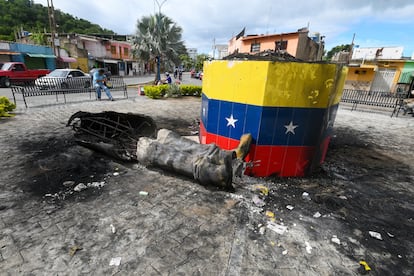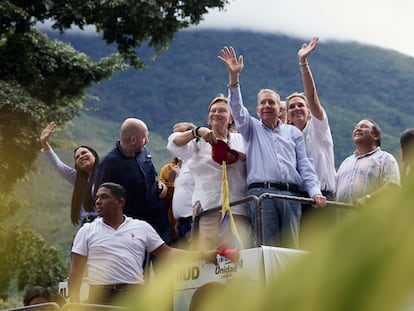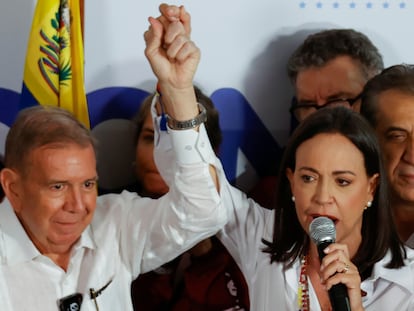Chávez beheaded
The toppling of five statues is a sign that Maduro’s government no longer has to pay tribute to the founding father of Chavismo in Venezuela

At least 79 teenagers have been jailed among more than 800 people arrested following protests in the wake of Venezuela’s presidential election. The demonstrations are being led by very young people, including those who took part in the toppling of statues of Hugo Chávez. At least five statues of the charismatic Venezuelan leader were knocked off their pedestals in two days. One of them was decapitated. Nicolás Maduro said that all “the criminals” had been captured: “If you saw how they were crying, there will be no forgiveness, there will be justice.”
The image of a headless Chávez may become a cliché for those trying to explain the transformation seen in Venezuela. However, the devil is in the details. In reality, the guillotine to cut off the head of a project that prioritized the country’s poorest was activated by a system imposed by Nicolás Maduro, who, locked in his bunker, long ago stopped listening to the most vulnerable. Now, in the midst of their growing protests, Maduro persecutes them, arrests them and calls them criminals, just for voting and demanding respect for his decision.
The political patricide began to take shape as soon as the seriousness of Chávez’s illness was understood, in December 2012. Eleven years after his death and on the day that marked the 70th anniversary of his birth, July 28, Maduro, his political heir, dealt the most brutal blow to the leader’s legacy: he ignored the popular will. Much of Chávez’s influence over his followers was based on his winning the elections, for which he invested in a powerful electronic voting system. So sure was Chávez of his ability to sway the masses.
Before the president’s death, the new nomenklatura eliminated, one by one, the so-called “children of Chávez”: first the political rivals, then the principles. This led to emblematic leaders being labeled as dissidents, even within the historic Communist Party of Venezuela.
Maduro established his circle of trust, a natural move in any succession. He applied a heavy hand against traditional opponents. Nor did he hesitate to fire, imprison or watch the death of faithful Chávez collaborators, such as General Isaías Baduel, who died in prison without trial. He was the architect of the operation that restored Chávez in April 2002, when opposition groups staged a coup d’état. Another target was General Miguel Rodríguez Torres, imprisoned for five years, who was exiled to Spain after the efforts of former Spanish prime minister José Luis Rodríguez Zapatero.
Last week’s protests quickly went viral on social media. In particular, a video of a young man tying the head of one of the beheaded Chávez statues to a rope. He is seen dragging it on his motorcycle through the neighborhood. As the brass head crashes against the pavement, other motorcycles join in. In the background of the hammering of discontent, people are heard chanting: “And it will fall, and it will fall, this government will fall.”
One of the boys arrested in the last five days is 12 years old. The organization Foro Penal has provided figures on 835 verified arrests. The average age of the detainees is 23: 79 of them are under 17 years old. Another organization, Monitor de Víctimas, reported that 19 people have been killed amid the protests. One of the victims is a teenager. Most of them are under 30 years old. Gonzalo Himiob, a human rights lawyer, says that one of the young men arrested is autistic and has not been allowed to contact his parents.
The government proudly claims to have deprived more than 1,200 people of their freedom. Some officials update their WhatsApp statuses that call on residents to “sapear” (report) the protesters. Like a Caribbean Crystal Night, they are hunting them down in the dark.
Meanwhile, the same story is being repeated in poor neighborhoods: “They took him out of the house”; “The [secret service] SEBIN took my cousin”; “they grabbed my brother”; “they took my wife”; “they are hunting us”; “I can’t find my boy”; “please, tell us where he is”…
Outside the overcrowded facilities holding the detainees, dozens of relatives beg for information, for permission to see them. In Caracas, on Thursday, a crowd of family members surrounded a man who was reading a list. When he came across the names of his family, he could not continue.
“Have strength,” said a woman, who relieved him in the macabre role.
On Friday, a taxi driver received a call. Suddenly he burst into tears. He told his passenger that he had been informed that his wife had just been arrested by the political police.
The repressive forces have gone after the protesters in their homes. Maduro, in the style of Nayib Bukele, announced that he will lock them up in two high-security prisons, so that they can then build roads, “like before, and they will be re-educated” (in reference to the dictatorship of Juan Vicente Gómez that ruled Venezuela for 27 years). The trials are beginning to hold mass hearings, remotely, because the anti-terrorist judges only operate from Caracas.
Contrary, perhaps, to the belief that the toppling of Chávez statues is due to anger against the former president, it is rather a symbol that Maduro’s government no longer has to pay tribute to the founding father. The dismemberment of the Chávez project was not only political. At the same time that Venezuela was seeing the changing of the guard, corruption and human rights violations were rising even more. Chávez turned a blind eye to the misappropriation of public funds, but during Maduro’s governments it became a way of life. In addition, the murders, torture and persecution of dissidents led the Prosecutor of the International Criminal Court to open an investigation into crimes against humanity, which has been ongoing since 2014.
In the president’s death throes, an iconic image was created: Chávez’s eyes, which were painted on buildings of the Housing Mission, a government program. From different walls, they seemed to watch every movement. The authoritarian character of the former president was tempered by a slogan: “Chávez, heart of the people.”
Chávez’s eyes were erased from almost all public spaces. If they weren’t, it was because there was no money for paint. The aesthetic, full of red color — even in official documents red ink was used — was gradually replaced by Google-type colors. In December 2023, Christmas in Caracas was decorated with Canadian pine trees and lights that sought to recall a boring American town. The decorations were also at the entrance to the Cuartel de la Montaña, in Caracas, which holds the former president’s mausoleum.
“Maduro is not Chávez” is a statement that was often used in Venezuela to express the sorrow at the loss of the charismatic leader. For years, the president’s successor sought to impose his own imprint. Today, he has unfortunately succeeded. To do so, he dismantled his political father’s ideals.
Sign up for our weekly newsletter to get more English-language news coverage from EL PAÍS USA Edition
Tu suscripción se está usando en otro dispositivo
¿Quieres añadir otro usuario a tu suscripción?
Si continúas leyendo en este dispositivo, no se podrá leer en el otro.
FlechaTu suscripción se está usando en otro dispositivo y solo puedes acceder a EL PAÍS desde un dispositivo a la vez.
Si quieres compartir tu cuenta, cambia tu suscripción a la modalidad Premium, así podrás añadir otro usuario. Cada uno accederá con su propia cuenta de email, lo que os permitirá personalizar vuestra experiencia en EL PAÍS.
¿Tienes una suscripción de empresa? Accede aquí para contratar más cuentas.
En el caso de no saber quién está usando tu cuenta, te recomendamos cambiar tu contraseña aquí.
Si decides continuar compartiendo tu cuenta, este mensaje se mostrará en tu dispositivo y en el de la otra persona que está usando tu cuenta de forma indefinida, afectando a tu experiencia de lectura. Puedes consultar aquí los términos y condiciones de la suscripción digital.
More information
Archived In
Últimas noticias
How Japan is trying to avert ‘digital defeat’
From digital curfews to blocking apps: How technology experts protect their children online
Why the price of coffee has skyrocketed: from Brazilian plantations to specialty coffee houses
Confined to a Cuban hospital: When electricity is a matter of life or death
Most viewed
- Pablo Escobar’s hippos: A serious environmental problem, 40 years on
- Reinhard Genzel, Nobel laureate in physics: ‘One-minute videos will never give you the truth’
- Why we lost the habit of sleeping in two segments and how that changed our sense of time
- Charles Dubouloz, mountaineering star, retires at 36 with a farewell tour inspired by Walter Bonatti
- The Florida Keys tourist paradise is besieged by immigration agents: ‘We’ve never seen anything like this’










































